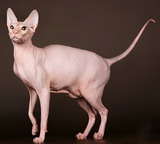History of the Don Sphynx
 Once upon a time lived in Rostov-on-Don a very ugly kitten. Or rather, not a kitten, but a cat Barbara. Barbara lived on the street and, of course, like all kittens, she dreamed of finding a home and owner. But the people who would have taken Barbara for themselves were in no way. Perhaps because the cat looked sick – small, thin, and also half bald. And Varvara had to live – until the nearest frost, if she had not met a kind woman Elena Kovaleva.
Once upon a time lived in Rostov-on-Don a very ugly kitten. Or rather, not a kitten, but a cat Barbara. Barbara lived on the street and, of course, like all kittens, she dreamed of finding a home and owner. But the people who would have taken Barbara for themselves were in no way. Perhaps because the cat looked sick – small, thin, and also half bald. And Varvara had to live – until the nearest frost, if she had not met a kind woman Elena Kovaleva.
Elena took the stray kitten home, fed, washed and treated for an unknown skin disease. But she could not cure Barbara, because the lack of wool on the cat was not a disease, but a congenital feature.
The breeder Irina Nemykina became interested in an unusual cat. Irina knew about the existence of naked sphinx cats in Canada and decided to withdraw her native breed. Barbara crossed with a cat Basil, a short-haired European. Their daughter Chita (very similar to the monkey), was born normal, but later bald. It is Chita that is considered the ancestor of Russian hairless cats.
The first bald kittens were born weak and small. To enhance the health of future sphinxes crossed with cats of other domestic breeds. European short-haired and mighty Siberians donated a bald cat to Don (the first name of the breed) its strength and vitality.
In 1993, at the first national exhibition of Russian aboriginal breeds, Don Sphynx drew the attention of specialists. Even then it became clear that a new breed of hairless cats had appeared in the country. Gradually, thanks to the efforts of Irina Nemykina, the standards of the breed were approved: first experimental, and later refined.
But real recognition came to the Don sphinxes only in 1998, at the conference of the World Cat Federation. The strict judges carefully listened to the report on the history of Rostov cats, discussed the cat standards, and together they decided: to be a breed! At the same time, the Don hairless began to be officially called the Don Sphynx, by analogy with the Canadians.
The Don Sphynx, in general, is similar to its Canadian counterpart, but there are also differences. Canadians are not completely naked, they are necessarily covered with sparse fur. And the bareborn Donchaks have not only wool, but also fluff. Their skin is more delicate than that of Canadians; it feels like rubber or plasticine to the touch.
Born sphinxes are one of the three main types of breed. There are also brushes, they are born with stiff, bristly hair all over their bodies, but by the age of two they are bald, in whole or in part. Donchas such as “flock” are also dressed in soft wool, which feels like velvet to the touch.
Don Sphynx – is graceful, graceful animals. But their main advantage is incredibly beautiful eyes. Almond-shaped, clearly defined and very expressive eyes of sphinxes can be green, yellowish or blue.
The front paws of sphinxes look like hands. Especially amusing, these cats look when they eat with their paws. It is a pleasure to watch the cat gently pick up a piece of food with her pink fingers and pull it into her mouth. In general, sphinxes love to eat and eat more than other cats.
These animals really appreciate the heat. Get on your knees, snuggle up to a warm battery – what could be better! Sphinx owners do not make sense to spend money on useless baskets and beds – still the Sphinx will sleep in their bed, under a warm blanket.
But do not think that the sphinx from the owners only need heat. These cats love communication, they are not aggressive at all, they are intelligent and feel the mood of a person well. Sphinxes love to play, not only with people, but also with other animals. Don hairless cats are so sociable and friendly, that in their behavior more likely resemble dogs.
Beautiful character, good health and outstanding appearance – the Don Sphynx has something to be proud of. It is not surprising that there are more and more connoisseurs of these unusual cats in the world. Today, the descendants of stray Barbara adorn the most prestigious cat show.


